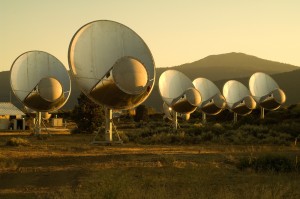Today the Allen Array Telescope is hibernating
NASA MESSENGER: Mercury has an orbiter (37 yrs after Venus)
March 29, 2011Allen Array Telescope and the SETI Institute
April 29, 2011First of all, a disclaimer: I am not NOT involved in the Allen Array Telescope, neither I conduct astronomical programs using radio telescopes. I am writing this post about the Allen Array Telescope (ATA) since it is a joint project effort by the SETI Institute and the Radio Astronomy Laboratory at the University of California, Berkeley and I am working for these institutions. This post describes the current situation for the ATA based on information collected after discussions with my colleagues at both institutions.
The Allen Array Telescope (ATA) is a radio interferometer located at Hat Creek Observatory, 300 miles north of San Francisco, California. The first-phase of the array with 42 antennas (ATA-42) was inaugurated on October 11 2007, shortly after I joined the Carl Sagan Center of the SETI Institute. The ATA-42 was funded by the Paul G. Allen Family Foundation totaling $25 million, and it has been in operation since them thanks to funding from UC Berkeley, the SETI Institute, the National Science Foundation, various corporations and individual donors. The ATA has a wide range of scientific goals including:
– Classify 250,000 extragalactic radio sources as active galactic nuclei or starburst galaxies
– Explore the transient sky due to accretion onto black holes and unknown phenomena
– Survey 1,000,000 stars for SETI emission
– Survey the 4×1010 billion stars of the inner Galactic Plane for very powerful, non-natural transmitters
Since its inauguration, the ATA-42 is used by a large community of astronomers and provided scientific results. It is also the main source of data of the SETIQuest project.
Unfortunately, the financial state of the observatory degraded significantly over the past 2 years with the lose of various sources of funding (NSF, California state) at UC Berkeley which forced this institution to step out of the project very recently. The array was in fact supposed to expand in four phases from 42, 98, 206 to 350 antennas in order to be fully competitive with respect to other projects (e.g. SKA). Additionally, because the project is mainly funded through private donors, the economic recession had a huge impact and delayed significantly the expansion of the array impacting the overall project.
The SETI Institute researchers explored over the past 2 years additional scientific opportunities for the array, because of its unique large field of view (2.5 deg at lambda=21 cm) and sensitivity. The array covers with no modifications the main space communications bands (S-band and X-band) and was proposed as a downlink for contestants in the Google Lunar X Prize. Starting in 2009, the Air Force Space Command has been evaluating the possible use of the ATA for its Space Situational Awareness. This program aims at detecting, tracking, identifying and cataloging all man-made objects in orbit around Earth. An unprecedented collision between an Iridium satellite and unused Russian satellite happened on February 10, 2009, creating a cloud of debris and reminding us that the close environment of our planet is now full of satellites and debris that needs to be followed up.
The first tests conducted with the ATA confirmed the usefulness of the array to detect debris and unused satellites with a size larger than 1 m2. In this wavelength range, the debris are spotted out using the reflection of radio wave from communication satellites such as Sirius spacecrafts. One advantage of the ATA compared to a classical telescopes (e.g. The Space Surveillance Telescope) is that these observations can be conducted days and nights and in any kind of weather.
The future of the ATA may depend of the US Air Force program. Unfortunately, because of the recent federal finance turmoil, no clear decision has been taken with enough time to keep the observatory running. Since April 15, the observatory is in hibernation. All the equipments have been taken care of to make sure that they do not deteriorate over time. Unfortunately, three members of the Hat Creek Observatory staff have received a lay off notice and one of them is moving to the CARMA observatory, a millimeter wave interferometer.
To summarize, funding from the US Air Force Space Command (AFPC) to include this facility to the space situational awareness program could keep the observatory alive, expand its capabilities since additional antennas will have to be built to improve its sensitivity. An upgrade of the receivers to get access to the Ku band, primarily used for satellite communications, is being also discussed. The time share between the scientific research and the space debris program is still unclear in the case of the successful agreement between the SETI Institute and AFPC.
The Allen Array Telescope has to reinvent itself. Let’s hope this event is just “a bump” in the life of this remarkable facility.
Clear Skies,
Franck Marchis (@AllPlanets)
EDIT on Monday April 25: If you want to support the ATA project, please visit the following web site http://www.seti.org/keplerworlds




1 Comment
Great.
This means that the entire SETI capability OF THE EARTH boils down to SETI@Home, SETI Italia, and me.
It is incomprehensible that 1/3 of the SETI capability of the Earth is made up of one 10 dish and a single person.
We, as a civilization, have serious problems with priorities.
Gasp… Jim
http://www.SETI.Net